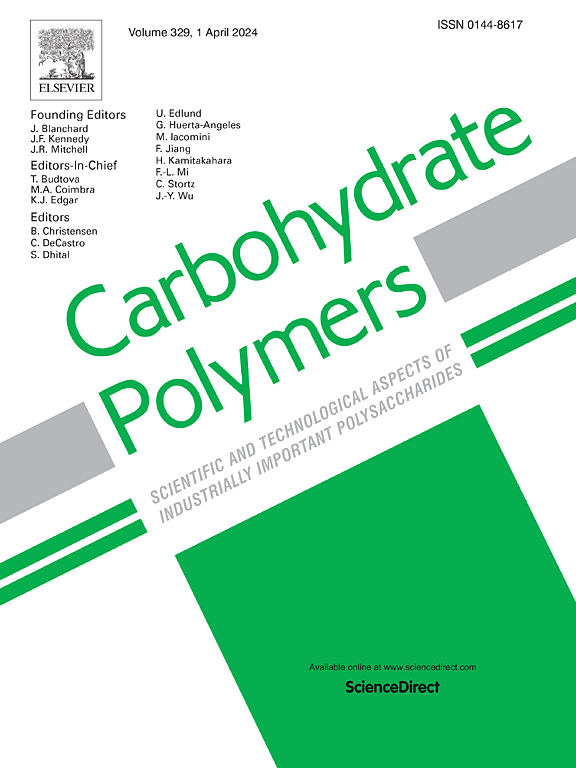High molecular weight laminarin/AgNPs-impregnated PVA based in situ hydrogels accelerated diabetic wound healing
IF 10.7
1区 化学
Q1 CHEMISTRY, APPLIED
引用次数: 0
Abstract
Diabetes exhibits several long-term serious health complications, including healing-impaired wounds, which result in substantial clinical challenges, warranting the need to develop efficient wound dressings. Herein, multifunctional in situ hydrogels as diabetic wound dressings were accomplished by concomitant spraying of 3-aminophenyl boronic acid (PBA)- grafted dialdehyde laminarin (LamPBA) and silver nanoparticles-impregnated polyvinyl alcohol (PVA-AgNPs). The hydrogels with and without AgNPs (F2 and F1, respectively) conferred excellent rheological characteristics and acceptable antibacterial activity (up to 80 % reduction in survival) against E. coli and S. aureus. Cellular experiments revealed that the hydrogels obviously promoted the proliferation and migration of HaCaT and NIH/3 T3 cells. In diabetic mice, the hydrogels accomplished ~90 % wound closure by day 9, outperforming controls (65–70 %). Additionally, F1 and F2 considerably increased the CD206/CD86 ratio (46 ± 5 and 62 ± 7, respectively) compared to diabetic (0.6 ± 0.1) and nondiabetic (2 ± 0.2) controls. Moreover, the hydrogels demonstrated remarkably triggered epidermal tissue regeneration, collagen deposition, antioxidant defense and angiogenesis. The hydrogels containing AgNPs portrayed superior wound healing potential over AgNP-free hydrogels. Overall, the in situ hydrogels (LamPBA/PVA-AgNPs, F2) could augment the diabetic wound healing rates in an effective manner and be utilized as promising wound care biomaterials.

高分子量层粘胶蛋白/ agnps浸渍PVA原位水凝胶加速糖尿病伤口愈合
糖尿病表现出几种长期严重的健康并发症,包括愈合受损的伤口,这给临床带来了重大挑战,因此需要开发有效的伤口敷料。本文通过同时喷涂3-氨基苯基硼酸(PBA)接枝的双醛层胺(LamPBA)和银纳米颗粒浸渍的聚乙烯醇(PVA-AgNPs),实现了多功能原位水凝胶作为糖尿病伤口敷料。含AgNPs和不含AgNPs的水凝胶(分别为F2和F1)具有优异的流变特性和可接受的抗菌活性(高达80%的存活率降低),可对抗大肠杆菌和金黄色葡萄球菌。细胞实验表明,水凝胶对HaCaT和NIH/3 T3细胞的增殖和迁移有明显的促进作用。在糖尿病小鼠中,水凝胶在第9天完成了~ 90%的伤口愈合,优于对照组(65 - 70%)。此外,与糖尿病对照组(0.6±0.1)和非糖尿病对照组(2±0.2)相比,F1和F2显著增加了CD206/CD86比值(分别为46±5和62±7)。此外,水凝胶还能显著促进表皮组织再生、胶原沉积、抗氧化防御和血管生成。含有AgNPs的水凝胶比不含AgNPs的水凝胶具有更好的伤口愈合潜力。综上所述,原位水凝胶(LamPBA/PVA-AgNPs, F2)可有效提高糖尿病创面愈合率,是一种有前景的创面护理生物材料。
本文章由计算机程序翻译,如有差异,请以英文原文为准。
求助全文
约1分钟内获得全文
求助全文
来源期刊

Carbohydrate Polymers
化学-高分子科学
CiteScore
22.40
自引率
8.00%
发文量
1286
审稿时长
47 days
期刊介绍:
Carbohydrate Polymers stands as a prominent journal in the glycoscience field, dedicated to exploring and harnessing the potential of polysaccharides with applications spanning bioenergy, bioplastics, biomaterials, biorefining, chemistry, drug delivery, food, health, nanotechnology, packaging, paper, pharmaceuticals, medicine, oil recovery, textiles, tissue engineering, wood, and various aspects of glycoscience.
The journal emphasizes the central role of well-characterized carbohydrate polymers, highlighting their significance as the primary focus rather than a peripheral topic. Each paper must prominently feature at least one named carbohydrate polymer, evident in both citation and title, with a commitment to innovative research that advances scientific knowledge.
 求助内容:
求助内容: 应助结果提醒方式:
应助结果提醒方式:


